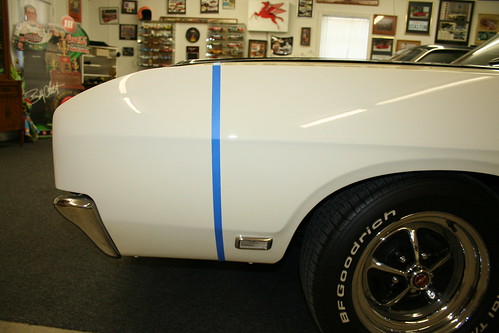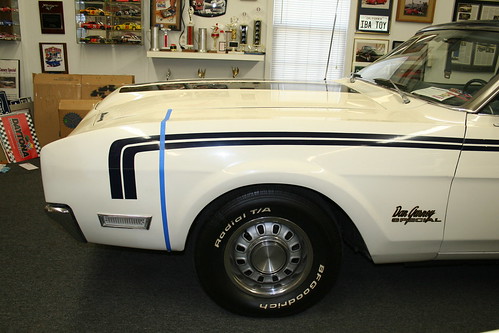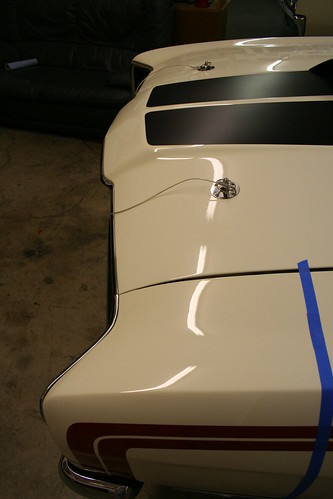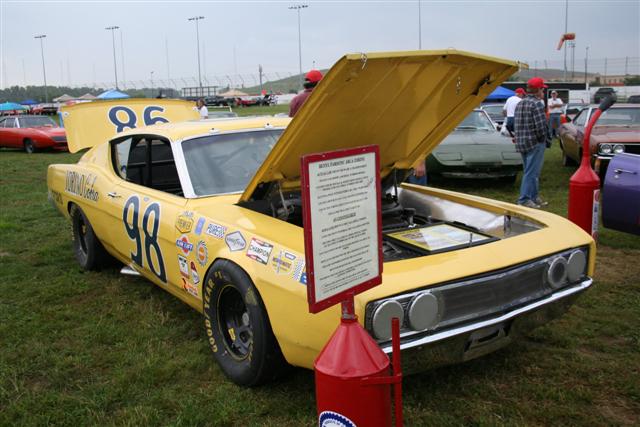1969 Mercury Cyclone Spoiler and Spoiler II Fenders


We all know that the 1969 Mercury Cyclone Spoiler II fenders started life as regular Cyclone fenders but how much was really used from the original fender? Where was it cut off? What was added? To build the NASCAR minimum of 500 cars was a tall order for Mercury. There were a lot of special parts required but none more noticeable than the front fenders.
The first step was to cut off just In front of a portion of the fenders just in front of the front tires. Then each Cyclone Spoiler II fender had 19.5 inches of new sheet metal added. An entirely new, sloped nose was then grafted onto the remaining original fenders. It was long been believed that Spoiler II cars were all built on the assembly line like the Talladega. However, based on a recent interview it was reported that the fenders were installed outside the assembly building in a different building! The fenders were first modified off site by an outside source and shipped to the factory for final finish and assembly onto the car.
Many believe the Ford Talladega and the Mercury Cyclone Spoiler II are identical. In fact the Talladega had only 15.5 inches added to its nose. The Spoiler II’s nose is not only longer it is also built at a steeper 35-degrees vs the Talladega’s 30-degrees. At high speeds these differences actually made the Spoiler II from 2 to 8 mph faster than the Talladega. Most also believe the Talladega and Spoiler II have identical bodies, this also is not true. The only shared components between the cars are the trunk lids. doors, bumpers, grilles, and turn signals!
This is a Spoiler II fender with all of the paint removed. You can see the original seams where the factory fenders were cut and the new sheet metal added.
Thanks to Wayne Perkins for this excellent photo of his Spoiler II under restoration.
This is an original Spoiler II with the seam marked with blue tape. The metal to the left is the new aero metal. Notice how close the bumper sits to the fender compared to the standard production Spoiler model below.
This is a restored Spoiler with the correct “W” nose fender. The blue tape marks the location where the factory cut the original fender to add the new aero metal. Also note that the side marker light is moved forward on the Spoiler II.
As point of comparison this is a Ford Talladega with the seam marked with blue tape. The extended nose is in front of the tape.
This is a full view of the Spoiler II’s extended fender.
As stated earlier, NASCAR mandated that at least 500 of these hand built extended nose cars had to be manufactured. According to some unconfirmed, rumors Mercury built only 351 out of a reported 503 units. How could they have done this? As the story goes, they built 351 extended “D” nosed cars; parked them in the front and on the edges of a parking lot; took 152 regular “W” nosed Cyclone Spoilers and parked them in the middle of all the Spoiler IIs in the parking lot. When NASCAR counted the cars they just never looked closely enough at the cars in the rear! Is this true or false? We have no way to prove it one way or the other, however, it must be known that the Marti Report states that 503 Spoiler IIs were manufactured. Because the Marti Report information is based on Ford records we will always consider there were 503 cars built until evidence is provided to prove otherwise.
Can you see the “W” in the nose of the standard factory Cyclone? Note that the hood is the end of the front end.
Now look at this Spoiler II with the extended nose; call the “D” nose or “long nose”. The panel in front of the hood was custom built and added by the factory. The blue line represents were the old sheet metal was cut off and the new aero metal added by the factory.
Note how similar this Talladega front end appears to be to the Spoiler II. In fact they are distinctly different and share no sheet metal between them.















Richard ?
You state in this story all the Spoiler II’s were built on the assembly line…..yet in the story you put together in Talladega Restoration Tips..Chris Vick states Louis Long told him he worked on the fenders and they were than put on off the line….
Our records show that the fender caps were stamped out by a out side company than sent to Kar Kraft where they were welded on the cut off factory fenders , than shipped to Lorain and put on the line as were the other Spoiler II parts. So just to keep history correct what is the right answer ? Were they put on ..on the line or in a special part of the Lorain plant ?
Rick Ochs
Good catch Rick. You are correct and I have made a correction to the story and added a link to the original story by Chris regarding where the fenders were installed.